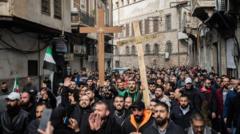In a shocking incident that has ignited public outcry, a Christmas tree was set ablaze in the central Syrian town of Suqaylabiyah, a stronghold of the Christian community. This act of vandalism has led to a wave of protests, urging the new Islamist leadership to fulfill pledges regarding minority rights. A video circulating on social media captured the moment the tree was engulfed in flames, igniting concerns among local inhabitants as they prepared for Christmas Eve celebrations.
Hayat Tahrir al-Sham (HTS), a dominant Islamist faction that played a significant role in the overthrow of President Bashar al-Assad, proclaimed the detention of foreign fighters associated with the incident. As protests spread to the capital, Damascus, demonstrators took to the streets holding crosses and Syrian flags, affirming their right to practice their faith without fear of persecution. Protesters voiced their frustrations, chanting slogans against foreign fighters, asserting, "Syria is free, non-Syrians should leave," reflecting a deep-seated issue of foreign influence in the region.
The incident has prompted calls from various groups, including minority stakeholders, for the new leadership to demonstrate a commitment to religious and ethnic pluralism in the war-torn nation. HTS has signaled a shift from its strict jihadist roots to a more inclusive approach, promising to protect the rights of diverse communities in Syria. However, with the backdrop of ongoing violence and the presence of formidable foreign fighters, skepticism remains regarding the sincerity of these assurances.
In an effort to redirect public sentiment, HTS officials have assured that the charred Christmas tree would be restored in time for celebrations, indicating an attempt to mend relations with local Christian communities. The newly appointed leaders, including Prime Minister Mohammed al-Bashir, have begun restructuring armed groups under a collective Ministry of Defence initiative, but questions linger about which factions will be involved in this consolidation and their past affiliations with HTS.
As the situation continues to unfold, the newly established authorities must navigate various challenges, including managing public expectations, dealing with foreign fighter dynamics, and ensuring a stable coexistence among the myriad ethnic and religious groups that populate Syria. With the complexities surrounding HTS's governance and the reactions of minority communities, the road ahead will be crucial in defining Syria's post-conflict future.
Hayat Tahrir al-Sham (HTS), a dominant Islamist faction that played a significant role in the overthrow of President Bashar al-Assad, proclaimed the detention of foreign fighters associated with the incident. As protests spread to the capital, Damascus, demonstrators took to the streets holding crosses and Syrian flags, affirming their right to practice their faith without fear of persecution. Protesters voiced their frustrations, chanting slogans against foreign fighters, asserting, "Syria is free, non-Syrians should leave," reflecting a deep-seated issue of foreign influence in the region.
The incident has prompted calls from various groups, including minority stakeholders, for the new leadership to demonstrate a commitment to religious and ethnic pluralism in the war-torn nation. HTS has signaled a shift from its strict jihadist roots to a more inclusive approach, promising to protect the rights of diverse communities in Syria. However, with the backdrop of ongoing violence and the presence of formidable foreign fighters, skepticism remains regarding the sincerity of these assurances.
In an effort to redirect public sentiment, HTS officials have assured that the charred Christmas tree would be restored in time for celebrations, indicating an attempt to mend relations with local Christian communities. The newly appointed leaders, including Prime Minister Mohammed al-Bashir, have begun restructuring armed groups under a collective Ministry of Defence initiative, but questions linger about which factions will be involved in this consolidation and their past affiliations with HTS.
As the situation continues to unfold, the newly established authorities must navigate various challenges, including managing public expectations, dealing with foreign fighter dynamics, and ensuring a stable coexistence among the myriad ethnic and religious groups that populate Syria. With the complexities surrounding HTS's governance and the reactions of minority communities, the road ahead will be crucial in defining Syria's post-conflict future.




















